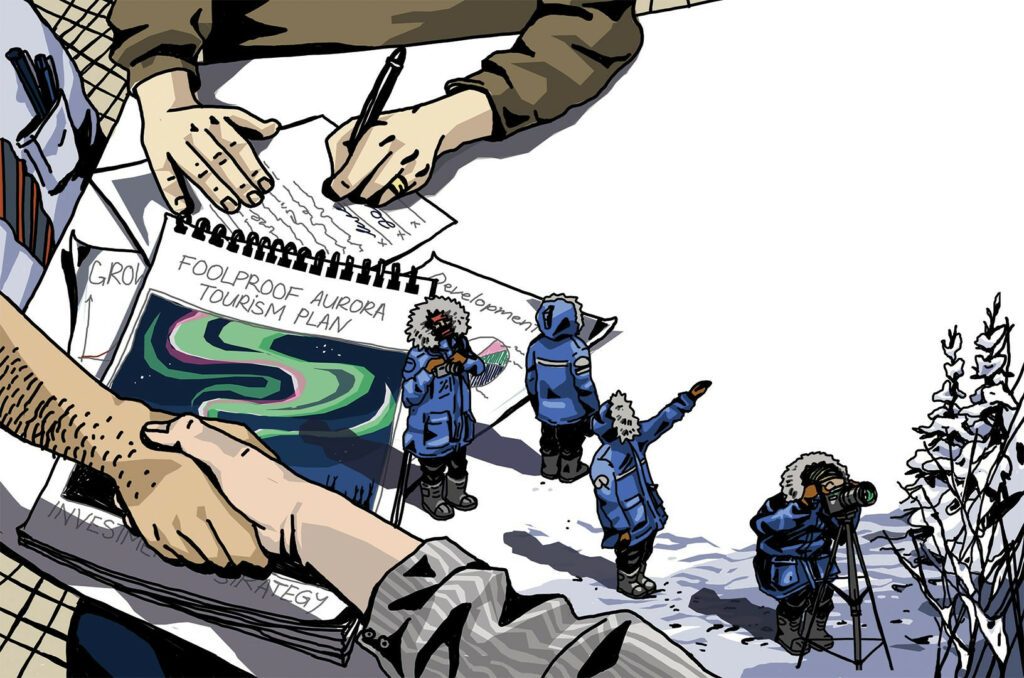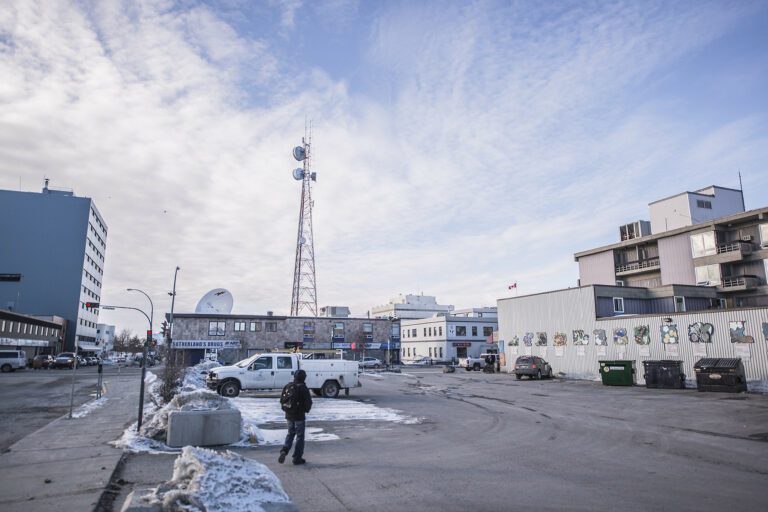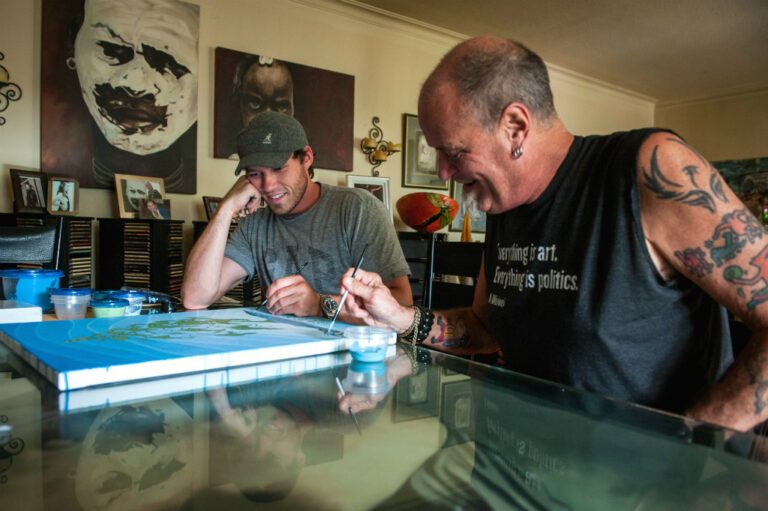How a plan that seemed so right, turned out so wrong
story by Jack Danylchuk
illustration by Alison McCreesh
Yellowknife’s history was carved out of the gold-bearing rock below, but its future lay in mining the treasures of its night sky – the fabled aurora borealis. At least that’s what the territorial government and a who’s-who list of Yellowknife investors believed when they bolstered up the aurora-viewing tourism industry — specifically Aurora World Corp. — about 10 years ago.
Back then, the swirl and shimmer of northern lights beckoned like a money-green banner, promising to bestow riches on all who staked a claim in the winter tourism market.
But that’s not what happened. The territorial government’s adventure in the aurora tourism business cost taxpayers more than $1.5 million and embroiled four of those investors – Grant Beck, Darryl Dolynny, the NWT Metis Development Corp. and Alex Arychuk – in a messy legal tussle to try to get them to pay the $100,000 they promised to pony up if Aurora World failed on their watch.
How did it all go so wrong?
The debt was owed to the NWT Business Development and Investment Corp., the latest in a succession of government-backed lending agencies that loaned $1.8 million to the ailing Aurora World and its predecessor Raven Tours to finance their play in the northern lights viewing market.
At last count, BDIC lost all but the $300,000 it recovered from the sale of Aurora World’s Prelude Lake viewing centre to Don Morin’s Aurora Village, after the investors recruited to save the company walked away from it.
The $1.5 million loss is the largest single hit to the fortunes of BDIC, the lender of last resort for the Northwest Territories, and not one that Pawan Chugh, the current president, or Dave Ramsay, the GNWT minister responsible for the corporation, is willing to discuss, citing the confidentiality agreement appended to the settlement reached this past spring with Aurora World investors.
All questions on the Aurora World file were referred to Doug McNiven, the lawyer who represented BDIC in its efforts to recover its investment in the bankrupt company. McNiven says that all answers can be found in the voluminous court records on the case.
The aurora business started in Yellowknife when Japanese tour brokers began shopping for destinations to satisfy demand for the spectacle and found Bill Tait, owner and operator of Raven Tours.
Tait rode the wave through the nineties, cashing in on the 11-year aurora cycle and the enthusiasm of Japanese tourists who talked up the new experience, glamorizing the journey into the bitter cold of a northern winter to see the dazzling lights.
As the millennium approached and the cycle promised another brilliant display, the aurora business was bright with promise.
“The aurora market is not a fad,” the authors of a government-commissioned report by Ellis Consulting wrote in 2002, but “sustainable with significant growth potential.” Aurora tourists were lighting up cash registers to the tune of an estimated $25.4 million for the 2001-02 winter tourist season, which would add $8 million to government tax coffers.
The only thing keeping more Japanese viewers from sharing the experience was investment in what looked like a gold mine in the sky. “If the NWT is marketed, the only limitation to aurora tourism growth is capacity, in infrastructure and attractions,” the report said, noting the market’s phenomenal growth to a predicted 15,600 visitors that year, from just 400 visitors a decade earlier.
The report’s authors watered their enthusiasm somewhat in a footnote that proved prophetic for Aurora World Corp: “The 2001-02 season does not reflect the estimated impact of the events of September 11th on the market,” they wrote, “but it is possible that this impact will be greater than anticipated. Nonetheless the market is expected to rebound and continue to grow.”
Much of that proved true. Bill Tait, now a travel consultant working out of Vancouver, remembers the 2001-02 season as a disaster for the Territory’s developing aurora market. “It wasn’t just 9/11, it was a perfect storm of events – the mad cow scare, bird flu, terror attacks in Spain.”
Aurora travel trouble
Aurora travel from Japan imploded, from almost 14,000 visitors in 2000-01 to 6,500 in the first post-9/11 season. Aurora World’s share was just 3,000 customers, nowhere near enough to service its debt with the territorial government. “We had to lay off tour guides, cancel leases on buses. It was a disaster,” said Tait.
In a bid to salvage the company, Tait brought in Alan Vaughn, former president of the NWT Development Corp., and accountant Grant Hinchey. They developed a plan to revive Aurora World and with Tait, recruited investors from Yellowknife’s business community.
Tait couldn’t recall all the names of all those who he said put up from $20,000 to $100,000 each, but they included Don Yamkowy, a travel company owner; Grant Beck, kennel owner and dog sled racer; pharmacist-entrepreneur Darryl Dolynny; Edward Eggenberger, YK Liquor Store owner and son of Raven Tours founder Albert Eggenberger; Shahram Yazanmehr; Fred Hunt, then head of Nunasi Corp.; Air Tindi founder Alex Arychuk and the NWT Metis Development Corp.
Going strictly by the numbers, Aurora World’s new management team was well positioned to save the company. After 9/11, the aurora market seemed to be on a sustained uptick: 9,000 visitors in 2002-2003, 9,990 the year after, and 10,245 in 2004-05 – but there were other factors in play.
Sage Suzuki viewed the aurora business from the vantage point of a small operator whose company, Canadian Ex, catered to groups of 30, bussing them to a rented property just far enough from Yellowknife to escape light pollution from the city and give the visitors a sense of the vastness of the surrounding wilderness.
The market is driven by the Japanese tour brokers, he said, and they have definite ideas about the product they want. Staffing was the deal-breaker for him. Guides were brought from Japan. Suzuki was their sponsor and only legal employer. In summer, when he pilots helicopters, he had no work for them. “I was always recruiting new people. It just got too difficult.”
When Suzuki closed the books on Canadian Ex and sold off the last of his bright-red parkas, Aurora World was barely keeping the lights on. It was in a price war with former premier Morin’s Aurora Village, and losing.
Bill Tait’s new partners threw him overboard, but the business kept sinking, despite the improving tourism numbers. The company had not made payments on its $1.8 million debt since December 2003, and owed another $1.2 million to suppliers, restaurants and the Canada Revenue Agency.
Risk of bankruptcy protection
“Aurora World Corporation is insolvent,” Garth Hinchey, by then the company’s chairman and CEO, wrote Peter Vician, then deputy minister of the GNWT’s Resources, Wildlife and Economic Development Department, in April 2004. “Unless reorganized, it runs the risk of seeking bankruptcy protection.”
Bankruptcy would be the easy way out for investors, Hinchey wrote, but “the effect on the local economy would be devastating as 12 businesses and individuals would also become bankrupt and the ripple effects would be felt for years. The Aurora industry would be lost forever with no person or business able to replace Aurora World, meaning the loss of $25 million in annual revenue to the NWT.”
RWED minister Brendan Bell was sympathetic, but made no promise beyond financial help to pay for professional advice in the search for a solution to Aurora World’s troubles.
But in October 2004 the BDIC (then known as the Business Credit Corp.) agreed to forgive $815,000 in loans, leaving Aurora world with a $1-million debt at seven per cent interest.
As if to applaud the bail-out plan, aurora visits held at 10,200 in 2005-06, but by the following year, the recovery took on the appearance of a dead-cat bounce. Visits fell to 7,000 in 2006-07, and then dipped even further with the onset of the world recession, to 5,460 in 2008-09. By then, Aurora World was out of business.
Darryl Bohnet, then chairman of Aurora World, delivered the bad news in an email to directors and investors. Aurora World could not meet its financial obligations and would close its doors Nov. 1, 2008. “With the numbers for the upcoming winter season looking bleak, we were just not able to continue,” he wrote.
All that remained was for the Business Development Investment Corp. to recover the $1.1 million in principal and interest, and the $100,000 four directors agreed to pay if they failed to turn around the fortunes of Aurora World Corp.
The Prelude Lake viewing centre was sold in 2009, bringing in almost $300,000. The guarantee proved more difficult, perhaps impossible. According to an affidavit from BDIC officer Chris Taylor, the directors tried more than once to wriggle free of their commitment.
Grant Beck, Darryl Dolynny, the NWT Metis Development Corp. and Alex Arychuk in September 2004, sought to have the guarantee terminated if they ceased to be directors. BDIC refused. In August of 2008, they admitted their liability, but a year later, in May 2009, they said the guarantee had a five-year limit. Again BDIC disagreed, Taylor said in his affidavit.
Finally, when pressed for payment, the four former directors claimed that during loan negotiations, BDIC officials and former minister Bell assured them that “in no event would BDIC enforce the personal guarantee,” and that “the entire cabinet were in support” of the deal.
Last March, BDIC filed a notice of motion with the NWT Supreme Court that said it could find no written evidence to support the directors’ claim that they had been induced to sign the guarantee. “The respondents have not produced any evidence, and may not rest on mere allegations or denials,” said the motion, which asked the court to order the directors to make good on their guarantees during a chambers hearing on April 13, a Friday.
Whatever agreement was reached that day, the details are private. Without explanation, the BDIC discontinued its action to recover the $100,000.
As the aurora cycle approaches another peak, the NWT is back on tourists’ bucket lists, but now it shares the business with Yukon, Nunavut and Alaska. In 2010-11, aurora visitors numbered 6,700, according to the Department of Industry Tourism and Investment — less than half the mark set a decade ago, when the sky seemed to be the only limit for aurora tourism operators.







